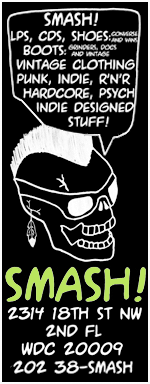
On November 11, Domino Records is set to release fresh vinyl editions of Beat Happening’s five studio albums: Beat Happening, Jamboree, Black Candy, Dreamy and You Turn Me On, plus the compilation Music to Climb the Apple Tree By. That’s damn near the band’s entire discography, a collected output striking in both a high standard of quality and consistent creative growth. The whole bunch gets evaluated below.
Of all the cornerstone outfits in the indie rock pantheon, it’s Beat Happening that arguably remains the most divisive. Some of the reasons why will be expanded upon farther down in the text, but let’s begin with how the instrument-switching, bass player-lacking band of Calvin Johnson (guitar and vocals), Heather Lewis (guitar, drums and vocals), and Bret Lunsford (guitar and drums) swung so far away from the nihilism, misanthropy, and shock value of the 1980s underground that many considered it them be a put-on. Once revealed to be wholly sincere, reactions ranged from dismissiveness to outright hostility.
Beat Happening was also insanely influential. Released in 1985 on the K label (co-founded by Johnson and Candice Pedersen), their self-titled debut was originally a tidy ten tracks quickly expanded to a dozen the following year in its UK edition on Rough Trade with the addition of the still stunning “Our Secret” b/w “What’s Important” 45 on side two. In 1990, The Feel Good All Over label included the album in its entirety, but not in sequence, on the 1983-85 compilation, the CD incarnation of which remains the definitive overview of the trio’s early years.
Domino’s 2LP comes very close to matching it however, and will very likely be preferable for folks who’ve never scored a vinyl copy of the debut, as the first album replicates the UK edition and the second is devoted to the era’s non-LP material, specifically the Tokyo-recorded “Three Tea Breakfast” cassette EP (their first release) and a few numbers from the various artists comp tapes Let’s Kiss and Let’s Sea (cassettes being K’s initial format of choice).
Unsurprisingly, sides three and four cohere into a sum that’s a little lesser than the original LP, but the bonus stuff still offers vivid portraiture of rapid-fire development while dishing a handful of classics in the trajectory, like the love ode optimism of “Honey Pot,” the heartache-tinged “The Fall,” and the resigned wisdom spiel of “Youth,” all songs sung by Johnson.
They combine terrifically with the excitement and frustration of “Run Down the Stairs” and “I Let Him Get to Me” with Lewis on vocals. And then there’s the simultaneously ridiculous and amazing “Christmas” to consider. Therein, Johnson divulges that having sex with three different women on the same day left him feeling…bored. It’s an early instance of Beat Happening diverting from the twee cliché that doggedly defined them for many non-fans.
The tracks on Beat Happening’s bonus disc do pinpoint the band’s comfort with lo-fi techniques, as most of the songs were seemingly captured with a single mic. This contrasts with the majority of the proper debut, which hits the ear as a modestly recorded studio set, with nine of the 12 songs produced by Greg Sage of The Wipers (for nearly all their subsequent output, the go-to producer was Steve Fisk).
Beat Happening includes the Lewis-sung gems “Foggy Eyes” and “Down at the Sea,” plus two selections that establish the band’s ’60s influences, both with Calvin at the mic, the teensploitation flick protest anthem “Bad Seeds” (in studio and live versions, a questionable double-dip perhaps) and the sleuth ode “I Spy,” which bursts from the tradition of Johnny Rivers’ “Secret Agent Man” and Edwin Starr’s “Agent Double-O-Soul.” Simultaneously formative and confident, the debut LP maintains a cozy quality that, along with the lyrical themes, spurred lingering accusations of “childlike.”
 The contrast with Jamboree is substantial, as Beat Happening’s second album commences with the gnawing buzzsaw duality of guitar and voice (Johnson’s natch) in “Bewitched,” with the song’s incessant Moe Tucker-ish drum thump (no cymbals) carrying over to the Lewis-sung “In Between” and extending into the record’s best-known song. That’d be “Indian Summer,” where the booming depth-heft of Johnson’s utterances really begin driving home a similarity to Lee Hazelwood.
The contrast with Jamboree is substantial, as Beat Happening’s second album commences with the gnawing buzzsaw duality of guitar and voice (Johnson’s natch) in “Bewitched,” with the song’s incessant Moe Tucker-ish drum thump (no cymbals) carrying over to the Lewis-sung “In Between” and extending into the record’s best-known song. That’d be “Indian Summer,” where the booming depth-heft of Johnson’s utterances really begin driving home a similarity to Lee Hazelwood.
“Hangman” throws in a sweet Cramps-like curve, a pair of stripped down vocal numbers strengthen ties to Beat Hap’s earliest stuff, “Crashing Through” delivers a legit pounder, and “Cat Walk” is a heart-aching indie pop classic. But maybe the record’s boldest maneuver is finale “The This Many Boyfriends Club,” where squealing feedback accompanies Johnson navigating the crevice between playground chant and emotional meltdown. It’s a perfect ending to a flawless and daring record. Jamboree is the ideal release to play for naysayers who parrot the tired accusations of Beat Happening being wimpy.
 Follow-up Black Candy pulls off an extremely difficult trick, as the set is marked by considerable refinement without losing impact or core essence. How exquisite is it to hear Johnson and Lewis duet in opener “Other Side”? Very. And how wonderful to soak up Johnson’s dark turn in the title track (sample lyric: “jackhammer, can’t stand her, can’t live unless I have her, sin dripping down my chin”)? Ditto.
Follow-up Black Candy pulls off an extremely difficult trick, as the set is marked by considerable refinement without losing impact or core essence. How exquisite is it to hear Johnson and Lewis duet in opener “Other Side”? Very. And how wonderful to soak up Johnson’s dark turn in the title track (sample lyric: “jackhammer, can’t stand her, can’t live unless I have her, sin dripping down my chin”)? Ditto.
There’s also the decidedly garage-psych-inclined “Pajama Party in a Haunted Hive,” as the late night lounge aura (with a twist of rockabilly) of “Grave Digger Blues” illustrates just how deft Beat Hap was getting; over on side two, the vibes-kissed “T.V. Girl” drives this point home with natural panache. Importantly, Black Candy offers another of their defining tunes in the sublime “Cast a Shadow,” but it also has “Playhouse,” a less celebrated song that’s registers as quintessential Beat Happening. The album concludes with the captivating slow build wall of sound of “Ponytail.”
 If Dreamy doesn’t equal the sheer brilliance of the prior two records, it don’t miss by much, and one positive development in particular helps it to stand out in the discography, as Lewis sings the openers to both sides of Dreamy; there’s the solid ’90s indie jangle of “Left Behind” on side one and the splendidly tempo-shifting “Collide” on the flip. As the latter plays, it’s tempting to rank it as the best of the LP’s Lewis-sung selections, but then the choruses of “Fortune Cookie Prize” arrives to stymie that assessment.
If Dreamy doesn’t equal the sheer brilliance of the prior two records, it don’t miss by much, and one positive development in particular helps it to stand out in the discography, as Lewis sings the openers to both sides of Dreamy; there’s the solid ’90s indie jangle of “Left Behind” on side one and the splendidly tempo-shifting “Collide” on the flip. As the latter plays, it’s tempting to rank it as the best of the LP’s Lewis-sung selections, but then the choruses of “Fortune Cookie Prize” arrives to stymie that assessment.
With Johnson at the mic, “Hot Chocolate Boy” reaffirms the prior album’s garage-psych tendencies and confirms Lunsford as johnny on the instrumental spot (an underemphasized factor, and yet not surprising given his non-singing status in Beat Hap’s equation). But Johnson’s strongest cuts on the set are the Link Wray-ish Sinatra-ode “Nancy Sin” and the album’s delightful finale “Red Head Walking,” which underscores just how together (if not necessarily tight) Beat Happening had become as a unit.
 “Red Head Walking” continues to flaunt and finesse that ’60s influence, an attribute that extends very attractively to final album You Turn Me On, the connection particularly strong in the fuzz guitar of “Pine Box Derby” and the crisp jangle pop of “Teenage Caveman,” with the latter’s surplus of Moe-beat and Lewis harmonizing in the choruses. And speaking of choruses, there’s Johnson’s refrain of “Turn Me On, Dead Man” in the title track, a song that always strikes me as the heaviest this band ever got.
“Red Head Walking” continues to flaunt and finesse that ’60s influence, an attribute that extends very attractively to final album You Turn Me On, the connection particularly strong in the fuzz guitar of “Pine Box Derby” and the crisp jangle pop of “Teenage Caveman,” with the latter’s surplus of Moe-beat and Lewis harmonizing in the choruses. And speaking of choruses, there’s Johnson’s refrain of “Turn Me On, Dead Man” in the title track, a song that always strikes me as the heaviest this band ever got.
Again, Lunsford deserves special praise for his contributions, as Beat Happening never falters instrumentally. But You Turn Me On’s most attractive facet is the triple-shot of “Noise,” “Sleepy Head,” and “Godsend,” three of the best tracks Lewis ever sung. Indeed, the nine minutes of loveliness that is “Godsend” is a standout in a record full of highs, with the six-minute “Bury the Hammer” a close second. Upon consideration, with the benefit of time, the band wrapped it all up near the apex of their game.
 Except they weren’t quite done, as they cut a pair of subsequent songs, “Zombie Limbo Time” in 1995 and “Angel Gone” in 2000, the tracks released that year on a 45 in K’s International Pop Underground series and then included on Music to Climb the Apple Tree By, a compilation first issued as part of the CD box set Crashing Through in 2002 and then separately on wax the next year.
Except they weren’t quite done, as they cut a pair of subsequent songs, “Zombie Limbo Time” in 1995 and “Angel Gone” in 2000, the tracks released that year on a 45 in K’s International Pop Underground series and then included on Music to Climb the Apple Tree By, a compilation first issued as part of the CD box set Crashing Through in 2002 and then separately on wax the next year.
Unlike the “Best of” 2LP Look Around that Domino put out back in 2015, Apple Tree is largely a round-up of 45s, stray B-sides, and comp tracks. While it lacks the full punch of the band’s LPs, the comp is still essential in the complete Beat Happening scheme, especially as it includes their 1987 EP in collaboration with The Screaming Trees; that set’s Cream-like “Polly Pereguinn” is a total knockout. There are a few other highpoints as well, like the superior second version of “Look Around” that kicked off the International Pop Underground series.
Note that these LPs form Domino’s We Are Beat Happening vinyl boxset, which appears to be still available.
Beat Happening
A-
Jamboree
A+
Black Candy
A+
Dreamy
A
You Turn Me On
A
Music to Climb the Apple Tree By
A-












































